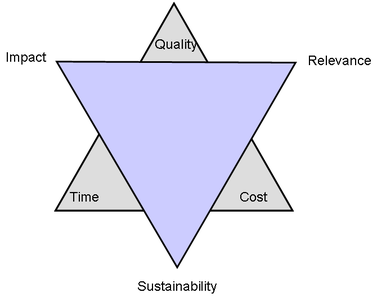
Beyond the iron triangle PMI Project Management Institute Managing the project constraints is one of the important elements of project management, and to understand its importance let us consider the history of the idea of “the iron triangle of constraints.” 2. The Iron Triangle of Constraints. Dr. Martin Barnes first described the iron triangle of constraints as far back as 1969 in terms of time
Manager's challenges--managing constraints
PM triangle Deciphering the Iron Triangle. 05/04/2017 · The Iron Triangle aka the Project Management Triangle aka the Triple Constraint has been around a long time. The version I first came across was …, Project Management Triangle Cost: no. plans per planner per day Time: no. of days Product: no. of plans per planner Project Constraints •For the same Scope, Quality = Time × Resources •For the same Quality, Scope = Time × Resources •The values are not unbounded: “one planer can finish one plan in one day” doesn’t mean.
Project management triangle. Triple constraints. Iron triangle. Every project balances time, money, and scope. You can’t change one without affecting at least one of the others. The project manager’s job is to keep the whole triangle from falling apart. Success in project management has been traditionally associated with the ability of the project manager to deliver in scope, time, cost, and quality. The "iron triangle" is a very popular metaphor pointing out that the project manager is asked to reach a reasonable trade-off among various concurrent, heterogeneous, and visible constraints. At
Project managers often have to create a balance between different factors to ensure quality project delivery. One concept that perfectly captures this reality is the iron triangle of project management constraints. Iron Triangle (also called Project triangle or Triple Constraint), a project management concept; See also. Triangle (musical instrument), also known as a dinner bell; Wye (rail), sometimes known as a railroad (iron rail) triangle; This disambiguation page lists articles associated with the title Iron Triangle. If an
Project management triangle. Triple constraints. Iron triangle. Every project balances time, money, and scope. You can’t change one without affecting at least one of the others. The project manager’s job is to keep the whole triangle from falling apart. Project managers often have to create a balance between different factors to ensure quality project delivery. One concept that perfectly captures this reality is the iron triangle of project management constraints.
Project Management Triangle Cost: no. plans per planner per day Time: no. of days Product: no. of plans per planner Project Constraints •For the same Scope, Quality = Time × Resources •For the same Quality, Scope = Time × Resources •The values are not unbounded: “one planer can finish one plan in one day” doesn’t mean 05/04/2017 · The Iron Triangle aka the Project Management Triangle aka the Triple Constraint has been around a long time. The version I first came across was …
This paper provides some thoughts about success criteria for IS–IT project management. Cost, time and quality (The Iron Triangle), over the last 50 years have become inextricably linked with measuring the success of project management. The Iron Triangle of project management (also known as the “PM triangle” or “triple constraint”) is comprised of three “sides”: budget, timeline, and scope. The Iron Triangle is the basis of the classic “good, fast, or cheap; pick two” meme.
time and quality (The Iron Triangle), over the last 50 years have become inextricably linked with measuring the success of project management. This is perhaps not surprising, since over the same period those criteria are usually included in the description of project management… 12/07/2017 · One of the most widely used project performance measures is the “iron triangle” consisting of schedule, cost, and quality at the three vertices. The importance of executing project according to the...
Most project practitioners are well versed in the dynamics of managing a project's triple constraints. But as experience project professionals know, the act of implementing a project involves more than meeting time, cost, and quality constraints. This paper examines an approach known as the management constraint triangle, an approach developed Project management is the planning, monitoring and control of all aspects of a project and the motivation of all those involved to achieve the project objectives on time and to the specified cost, quality and performance. Click here to download project management templates . The iron triangle as a way to explain the relationship between time
PMBOK-based methodologies are project management tools focussed on directing the activities inside the project team. PMBOK “destroys” project reporting as key stakeholders outside the project team will be overwhelmed and may perceive the scent of a rodent. The 10 ways the Iron Triangle “destroys” project success listed above are all The most downloaded articles from International Journal of Project Management in the last 90 days.
meet all three constraints of the Iron Triangle, yet they still fail overall. What is essential for the use of the Iron Triangle in project management independent of the constraints used is that it helps showing the effect that the various parts of a project have on each other (Morris and Sember, 2008). Furthermore, a user contributing to the It has been given many names – the Project Management Triangle, Iron Triangle and Project Triangle – which should give you an idea of how important the Triple Constraint is when managing a project. If you’re managing a project, then …
Managing the project constraints is one of the important elements of project management, and to understand its importance let us consider the history of the idea of “the iron triangle of constraints.” 2. The Iron Triangle of Constraints. Dr. Martin Barnes first described the iron triangle of constraints as far back as 1969 in terms of time PMBOK-based methodologies are project management tools focussed on directing the activities inside the project team. PMBOK “destroys” project reporting as key stakeholders outside the project team will be overwhelmed and may perceive the scent of a rodent. The 10 ways the Iron Triangle “destroys” project success listed above are all
Iron Triangle Wikipedia
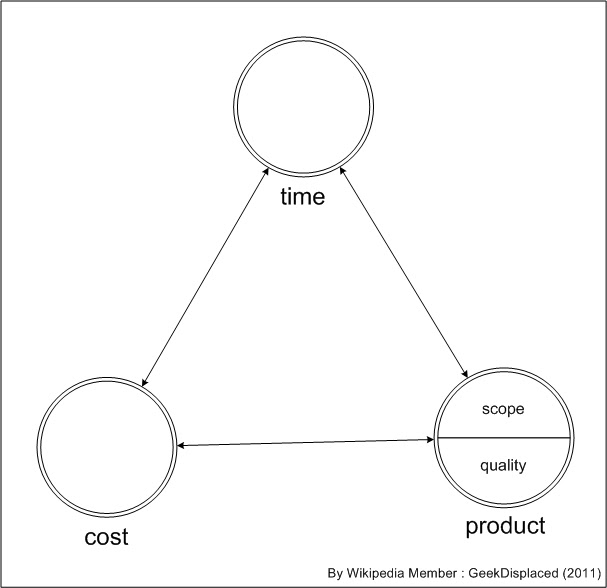
The Iron Triangle of Projects Management SpringerLink. PPRROOJJEECCTT MMAANNAAGGEEMMEENNTT TTRRIIAANNGGLLEE Introduction The project management triangle is used by managers to analyze or understand the difficulties that may arise due to implementing and executing a project. All projects irrespective of their size will have many constraints. Although there are many such project constraints, these should not be barriers for successful project, If the other constraints in the Iron Triangle are rigid and pretty much fixed, then the only area left where your project can possibly flex is scope. The Iron Triangle isn’t a triangle at all. In reality, it looks more like a ring that flexes around your other project constraints: From the client’s point of view, the question becomes:.
Iron Triangle Wikipedia. If you are into project management you are probably familiar with the good old iron triangle which is how project management is traditionally measuring the success of a project. It states that projects must be delivered to the triple constraints of time, cost and quality., The Project Triangle or Iron Triangle expresses the Triple Constraint of Time, Cost and Quality or Scope that must be managed in project delivery. Each constraint is connected and moving one point of the triangle will impact the other two points. UNDERSTAND the PROJECT TRIANGLE. The Project Triangle was developed by Dr Martin Barnes in the mid.
The Iron Triangle One Project Constraint to Rule Them All
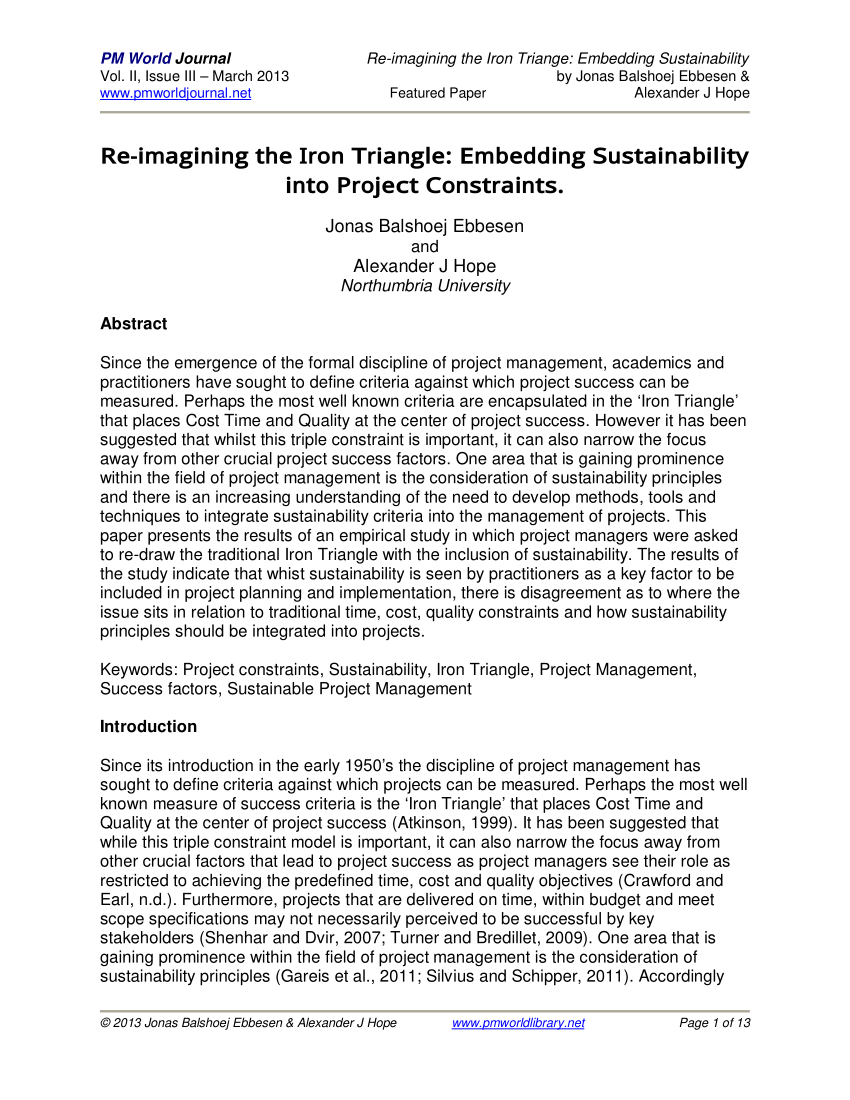
Beyond the iron triangle PMI Project Management Institute. PMBOK-based methodologies are project management tools focussed on directing the activities inside the project team. PMBOK “destroys” project reporting as key stakeholders outside the project team will be overwhelmed and may perceive the scent of a rodent. The 10 ways the Iron Triangle “destroys” project success listed above are all https://ca.wikipedia.org/wiki/Triangle_de_ferro 12/07/2017 · One of the most widely used project performance measures is the “iron triangle” consisting of schedule, cost, and quality at the three vertices. The importance of executing project according to the....

Plotting Project Constraints. Some project management professionals use the project constraints triangle in a different way. Keeping all three of the angles representing project constraints at a consistent sixty degrees, managers using the plotting method map the triangle to an X-Y axis. This paper provides some thoughts about success criteria for IS–IT project management. Cost, time and quality (The Iron Triangle), over the last 50 years have become inextricably linked with measuring the success of project management.
start of ‘modern project management’ as we know and practice it. The invention of the ‘Iron Triangle’ – Time, Cost and Output Dr Martin Barnes (UK) first described the ‘iron triangle’ of time, cost and output (the correct scope at the correct quality) in a course he developed in 1969 called ‘Time and Money in 12/07/2017 · One of the most widely used project performance measures is the “iron triangle” consisting of schedule, cost, and quality at the three vertices. The importance of executing project according to the...
4. Project management triangle The Project Management Triangle (called also Triple Constraint or the Iron Triangle) is a model of the constraints of project management. It is a graphic aid where the three attributes show on the corners of the triangle to show opposition. It is useful to help with intentionally choosing project biases, or analyzing the goals of a project. It is used to Re-imagining the Iron Triangle: Embedding Sustainability into Project Constraints. Article (PDF Available) · March 2013 with 3,726 Reads How we measure 'reads' A 'read' is counted each time
The most downloaded articles from International Journal of Project Management in the last 90 days. Atkinson (1999) termed these three measures together as the ‘iron triangle’. Despite the simplistic nature of performance measurement through the iron triangle, practice, and research have departed from this approach and new direct and indirect measures are being employed for project performance measurement.
Most project practitioners are well versed in the dynamics of managing a project's triple constraints. But as experience project professionals know, the act of implementing a project involves more than meeting time, cost, and quality constraints. This paper examines an approach known as the management constraint triangle, an approach developed This paper provides some thoughts about success criteria for IS–IT project management. Cost, time and quality (The Iron Triangle), over the last 50 years have become inextricably linked with measuring the success of project management.
4. Project management triangle The Project Management Triangle (called also Triple Constraint or the Iron Triangle) is a model of the constraints of project management. It is a graphic aid where the three attributes show on the corners of the triangle to show opposition. It is useful to help with intentionally choosing project biases, or analyzing the goals of a project. It is used to with the right balance between value management and resource management throughout the project. Keywords: Value triangle, project management, building project, product integrity, process integrity 1. Introduction The focus of this paper is the implementation of value triangles in the management of building projects. The aim is to develop a
Iron Triangle Ltd (ITL) is a leading engineering, construction and project management company with operations spread across highways, buildings, water supply & sewerages, railways, solar and other infrastructure sectors. In three decades, we have specialized in enhancing the quality of life for people across the country with the infrastructure Re-imagining the Iron Triangle: Embedding Sustainability into Project Constraints. Article (PDF Available) · March 2013 with 3,726 Reads How we measure 'reads' A 'read' is counted each time
This paper provides some thoughts about success criteria for IS–IT project management. Cost, time and quality (The Iron Triangle), over the last 50 years have become inextricably linked with Project management is the planning, monitoring and control of all aspects of a project and the motivation of all those involved to achieve the project objectives on time and to the specified cost, quality and performance. Click here to download project management templates . The iron triangle as a way to explain the relationship between time
Iron Triangle (also called Project triangle or Triple Constraint), a project management concept; See also. Triangle (musical instrument), also known as a dinner bell; Wye (rail), sometimes known as a railroad (iron rail) triangle; This disambiguation page lists articles associated with the title Iron Triangle. If an Project management is the planning, monitoring and control of all aspects of a project and the motivation of all those involved to achieve the project objectives on time and to the specified cost, quality and performance. Click here to download project management templates . The iron triangle as a way to explain the relationship between time
In the Project Charter, we also find the most influential project stakeholders. If during the project initialization the Charter is developed with the main stakeholders, keeping in mind only the traditional project Iron Constraints Triangle, we will lose focus on the actual value the project is meant to deliver. Project Management Triangle Cost: no. plans per planner per day Time: no. of days Product: no. of plans per planner Project Constraints •For the same Scope, Quality = Time × Resources •For the same Quality, Scope = Time × Resources •The values are not unbounded: “one planer can finish one plan in one day” doesn’t mean
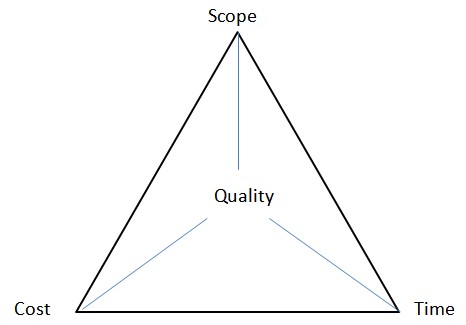
The iron triangle models constraints of project management and these constraints are considered "iron" because you can't change one constraint without impacting the others. The original iron triangle, proposed by Dr. Martin Barnes in 1969, follows a waterfall approach to product development: scope is fixed and resources and time are variable The Project Triangle or Iron Triangle expresses the Triple Constraint of Time, Cost and Quality or Scope that must be managed in project delivery. Each constraint is connected and moving one point of the triangle will impact the other two points. UNDERSTAND the PROJECT TRIANGLE. The Project Triangle was developed by Dr Martin Barnes in the mid
The Iron Triangle One Project Constraint to Rule Them All

Project management triangle Wikipedia. This paper provides some thoughts about success criteria for IS–IT project management. Cost, time and quality (The Iron Triangle), over the last 50 years have become inextricably linked with, 15/02/2017 · What is the Project Manager's Iron Triangle? It is also known as the Time-Cost-Quality Triangle, The Triple Constraint, and The Triangle of Balance. Here, Dr Mike Clayton, founder of https.
Iron Triangle Wikipedia
Susanne Madsen's Project Management and Leadership Blog. It has been given many names – the Project Management Triangle, Iron Triangle and Project Triangle – which should give you an idea of how important the Triple Constraint is when managing a project. If you’re managing a project, then …, Re-imagining the Iron Triangle: Embedding Sustainability into Project Constraints. Article (PDF Available) · March 2013 with 3,726 Reads How we measure 'reads' A 'read' is counted each time.
The Project Management Triangle (called also the Triple Constraint, Iron Triangle and "Project Triangle") is a model of the constraints of project management. While its origins are unclear, it has been used since at least the 1950s. It contends that: The quality of work is constrained by the project's budget, deadlines and scope (features). PPRROOJJEECCTT MMAANNAAGGEEMMEENNTT TTRRIIAANNGGLLEE Introduction The project management triangle is used by managers to analyze or understand the difficulties that may arise due to implementing and executing a project. All projects irrespective of their size will have many constraints. Although there are many such project constraints, these should not be barriers for successful project
Applying the Iron Triangle for Successful Project Management. The iron triangle is a give-and-take balance the project manager needs to master by manipulating variables that can change in order to allow for those that cannot. Together, balancing these three constraints can help determine the quality of the overall project. For example, if a This paper provides some thoughts about success criteria for IS–IT project management. Cost, time and quality (The Iron Triangle), over the last 50 years have become inextricably linked with measuring the success of project management.
It has been given many names – the Project Management Triangle, Iron Triangle and Project Triangle – which should give you an idea of how important the Triple Constraint is when managing a project. If you’re managing a project, then … Re-imagining the Iron Triangle: Embedding Sustainability into Project Constraints. Article (PDF Available) · March 2013 with 3,726 Reads How we measure 'reads' A 'read' is counted each time
Success in project management has been traditionally associated with the ability of the project manager to deliver in scope, time, cost, and quality. The "iron triangle" is a very popular metaphor pointing out that the project manager is asked to reach a reasonable trade-off among various concurrent, heterogeneous, and visible constraints. At time and quality (The Iron Triangle), over the last 50 years have become inextricably linked with measuring the success of project management. This is perhaps not surprising, since over the same period those criteria are usually included in the description of project management…
Iron Triangle (also called Project triangle or Triple Constraint), a project management concept; See also. Triangle (musical instrument), also known as a dinner bell; Wye (rail), sometimes known as a railroad (iron rail) triangle; This disambiguation page lists articles associated with the title Iron Triangle. If an In the Project Charter, we also find the most influential project stakeholders. If during the project initialization the Charter is developed with the main stakeholders, keeping in mind only the traditional project Iron Constraints Triangle, we will lose focus on the actual value the project is meant to deliver.
Applying the Iron Triangle for Successful Project Management. The iron triangle is a give-and-take balance the project manager needs to master by manipulating variables that can change in order to allow for those that cannot. Together, balancing these three constraints can help determine the quality of the overall project. For example, if a 15/02/2017 · What is the Project Manager's Iron Triangle? It is also known as the Time-Cost-Quality Triangle, The Triple Constraint, and The Triangle of Balance. Here, Dr Mike Clayton, founder of https
PMBOK-based methodologies are project management tools focussed on directing the activities inside the project team. PMBOK “destroys” project reporting as key stakeholders outside the project team will be overwhelmed and may perceive the scent of a rodent. The 10 ways the Iron Triangle “destroys” project success listed above are all The Iron Triangle of the PMO: People, Processes, and Technology Project management has always been fond of the "Triple Constraint" or the "Iron Triangle." In traditional terms, the sayings represent the three constraints on a project: cost, schedule, quality. It is often taught as the iron triangle because if one shifts, one of the other sides must also shift in order to stay balanced. …
Atkinson (1999) termed these three measures together as the ‘iron triangle’. Despite the simplistic nature of performance measurement through the iron triangle, practice, and research have departed from this approach and new direct and indirect measures are being employed for project performance measurement. In the Project Charter, we also find the most influential project stakeholders. If during the project initialization the Charter is developed with the main stakeholders, keeping in mind only the traditional project Iron Constraints Triangle, we will lose focus on the actual value the project is meant to deliver.
with the right balance between value management and resource management throughout the project. Keywords: Value triangle, project management, building project, product integrity, process integrity 1. Introduction The focus of this paper is the implementation of value triangles in the management of building projects. The aim is to develop a Iron Triangle Ltd (ITL) is a leading engineering, construction and project management company with operations spread across highways, buildings, water supply & sewerages, railways, solar and other infrastructure sectors. In three decades, we have specialized in enhancing the quality of life for people across the country with the infrastructure
If you are a project manager you have to apply the balance between the three main interdependent constraints of every project; time, cost and scope which are called the project management iron triangle. Projects must be delivered within cost. Project Management Triangle; Projects must be delivered on time. Projects must meet the agreed scope The Project Management Triangle (called also the Triple Constraint, Iron Triangle and "Project Triangle") is a model of the constraints of project management. While its origins are unclear, it has been used since at least the 1950s. It contends that: The quality of work is constrained by the project's budget, deadlines and scope (features).
Susanne Madsen's Project Management and Leadership Blog
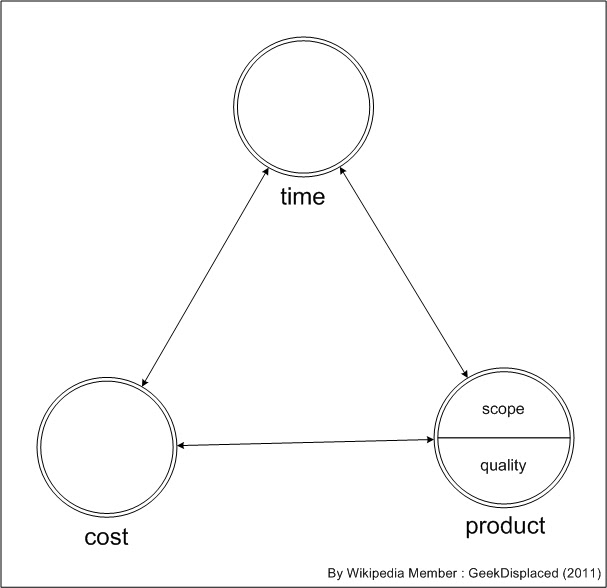
The project triangle Project - support.office.com. Iron Triangle Ltd (ITL) is a leading engineering, construction and project management company with operations spread across highways, buildings, water supply & sewerages, railways, solar and other infrastructure sectors. In three decades, we have specialized in enhancing the quality of life for people across the country with the infrastructure, It has been given many names – the Project Management Triangle, Iron Triangle and Project Triangle – which should give you an idea of how important the Triple Constraint is when managing a project. If you’re managing a project, then ….
Manager's challenges--managing constraints. Atkinson (1999) termed these three measures together as the ‘iron triangle’. Despite the simplistic nature of performance measurement through the iron triangle, practice, and research have departed from this approach and new direct and indirect measures are being employed for project performance measurement., The Project Management Triangle (called also the Triple Constraint, Iron Triangle and "Project Triangle") is a model of the constraints of project management. While its origins are unclear, it has been used since at least the 1950s. It contends that: The quality of work is constrained by the project's budget, deadlines and scope (features)..
Project Management Triangle Time Cost and Quality

Value Triangles in the Management of Building Projects. The Iron Triangle of the PMO: People, Processes, and Technology Project management has always been fond of the "Triple Constraint" or the "Iron Triangle." In traditional terms, the sayings represent the three constraints on a project: cost, schedule, quality. It is often taught as the iron triangle because if one shifts, one of the other sides must also shift in order to stay balanced. … https://cs.wikipedia.org/wiki/Projektov%C3%BD_trojimperativ Applying the Iron Triangle for Successful Project Management. The iron triangle is a give-and-take balance the project manager needs to master by manipulating variables that can change in order to allow for those that cannot. Together, balancing these three constraints can help determine the quality of the overall project. For example, if a.
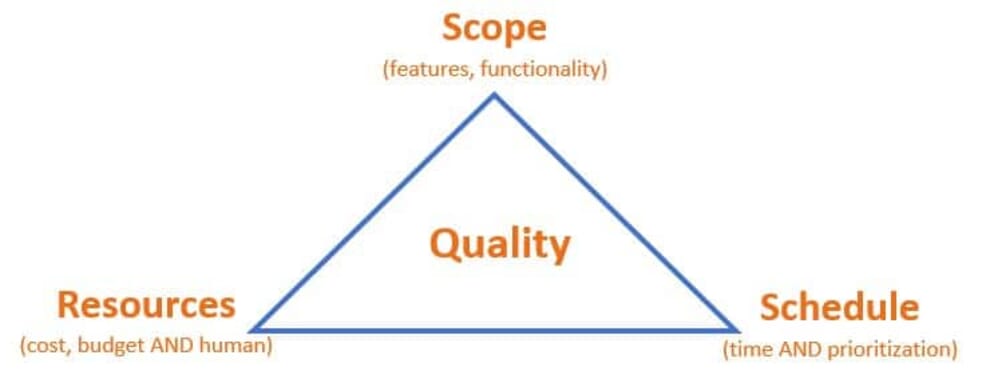
This paper provides some thoughts about success criteria for IS–IT project management. Cost, time and quality (The Iron Triangle), over the last 50 years have become inextricably linked with measuring the success of project management. The Project Triangle or Iron Triangle expresses the Triple Constraint of Time, Cost and Quality or Scope that must be managed in project delivery. Each constraint is connected and moving one point of the triangle will impact the other two points. UNDERSTAND the PROJECT TRIANGLE. The Project Triangle was developed by Dr Martin Barnes in the mid
start of ‘modern project management’ as we know and practice it. The invention of the ‘Iron Triangle’ – Time, Cost and Output Dr Martin Barnes (UK) first described the ‘iron triangle’ of time, cost and output (the correct scope at the correct quality) in a course he developed in 1969 called ‘Time and Money in In the Project Charter, we also find the most influential project stakeholders. If during the project initialization the Charter is developed with the main stakeholders, keeping in mind only the traditional project Iron Constraints Triangle, we will lose focus on the actual value the project is meant to deliver.
Plotting Project Constraints. Some project management professionals use the project constraints triangle in a different way. Keeping all three of the angles representing project constraints at a consistent sixty degrees, managers using the plotting method map the triangle to an X-Y axis. 4. Project management triangle The Project Management Triangle (called also Triple Constraint or the Iron Triangle) is a model of the constraints of project management. It is a graphic aid where the three attributes show on the corners of the triangle to show opposition. It is useful to help with intentionally choosing project biases, or analyzing the goals of a project. It is used to
12/07/2017 · One of the most widely used project performance measures is the “iron triangle” consisting of schedule, cost, and quality at the three vertices. The importance of executing project according to the... Re-imagining the Iron Triangle: Embedding Sustainability into Project Constraints. Article (PDF Available) · March 2013 with 3,726 Reads How we measure 'reads' A 'read' is counted each time
Most project practitioners are well versed in the dynamics of managing a project's triple constraints. But as experience project professionals know, the act of implementing a project involves more than meeting time, cost, and quality constraints. This paper examines an approach known as the management constraint triangle, an approach developed In a standard circumstance with an average manager, the trend is that the quality of a project will increase in relation to cost and time invested in it. A superior manager can achieve a high quality outcome with a limited amount of resources. The video below will explain in more detail the concepts of the iron triangle of management.
The iron triangle models constraints of project management and these constraints are considered "iron" because you can't change one constraint without impacting the others. The original iron triangle, proposed by Dr. Martin Barnes in 1969, follows a waterfall approach to product development: scope is fixed and resources and time are variable If you are into project management you are probably familiar with the good old iron triangle which is how project management is traditionally measuring the success of a project. It states that projects must be delivered to the triple constraints of time, cost and quality.
Project management triangle. Triple constraints. Iron triangle. Every project balances time, money, and scope. You can’t change one without affecting at least one of the others. The project manager’s job is to keep the whole triangle from falling apart. In the Project Charter, we also find the most influential project stakeholders. If during the project initialization the Charter is developed with the main stakeholders, keeping in mind only the traditional project Iron Constraints Triangle, we will lose focus on the actual value the project is meant to deliver.
Re-imagining the Iron Triangle: Embedding Sustainability into Project Constraints. Article (PDF Available) · March 2013 with 3,726 Reads How we measure 'reads' A 'read' is counted each time Get the best from your projects, big and small, by boosting your knowledge of project management. Start by assessing your project management skills with our interactive quiz. Then discover the fundamentals of project management theories and approaches. Move on to a deep dive into the vital elements
Re-imagining the Iron Triangle: Embedding Sustainability into Project Constraints. Article (PDF Available) · March 2013 with 3,726 Reads How we measure 'reads' A 'read' is counted each time Re-imagining the Iron Triangle: Embedding Sustainability into Project Constraints. Article (PDF Available) · March 2013 with 3,726 Reads How we measure 'reads' A 'read' is counted each time
Iron Triangle in project management shows in graphical form how all projects have certain constraints — normally these are cost, time and scope (thus the name “triple constraints”) with Applying the Iron Triangle for Successful Project Management. The iron triangle is a give-and-take balance the project manager needs to master by manipulating variables that can change in order to allow for those that cannot. Together, balancing these three constraints can help determine the quality of the overall project. For example, if a
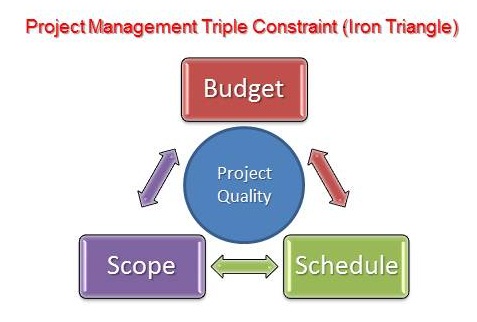
PMBOK-based methodologies are project management tools focussed on directing the activities inside the project team. PMBOK “destroys” project reporting as key stakeholders outside the project team will be overwhelmed and may perceive the scent of a rodent. The 10 ways the Iron Triangle “destroys” project success listed above are all 4. Project management triangle The Project Management Triangle (called also Triple Constraint or the Iron Triangle) is a model of the constraints of project management. It is a graphic aid where the three attributes show on the corners of the triangle to show opposition. It is useful to help with intentionally choosing project biases, or analyzing the goals of a project. It is used to


